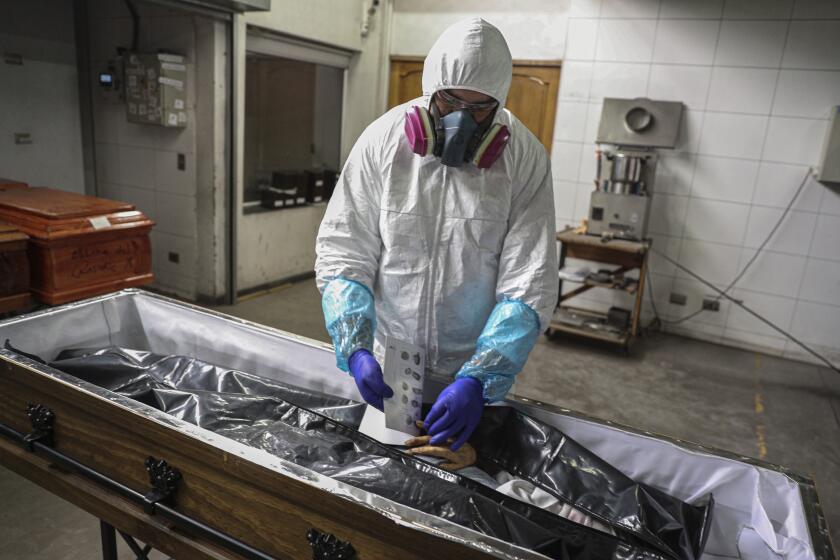HEATH HORIZONS : MEDICINE : Ice, the Wonder Drug : DOCTORS AND ATHLETES HAVE KNOWN FOR YEARS THAT IT PROMOTES HEALING, RELIEVES PAIN, HAS NO TOXIC SIDE EFFECTS, COSTS ALMOST NOTHING, AND DOESN’T REQUIRE A PRESCRIPTION.
The 38-year-old woman on a ski vacation was taken to the Orthopedic Specialty Hospital in Salt Lake City last winter after an accident. Her knee was a mess.
After surgery to reconstruct the ligaments, the knee was wrapped in a pad that was attached to a machine by a hose. The device circulated ice water continuously into the hose and through the pad--the equivalent of a giant ice pack.
Dr. Brian Victoroff, one of the orthopedic surgeons involved in the operation, remembers visiting his patient the next morning to ask if she was receiving enough medication for her postoperative pain.
Her response did not surprise him, for he had heard it many times before. “I haven’t needed any,” she replied. “This ice thing has been enough. It’s wonderful.”
The woman had learned what orthopedic surgeons, physical therapists, sports medicine specialists and professional athletes have known for years: Ice is a wonder drug.
It promotes healing, relieves pain, has no toxic side effects, costs almost nothing, and doesn’t require a prescription. And it’s as close as the nearest freezer.
The only problem is, for most people, its wondrous medicinal effects have remained undiscovered.
“Ice is extremely powerful,” says 1972 Olympian Jeff Galloway, who has suffered more than his share of running injuries over the years. “Very few people either know about it, or use ice the right way. But maybe it’s too simple and too obvious.”
“People don’t use it enough,” says Dr. Ken Fine, an orthopedic surgeon/sports medicine specialist at George Washington University Medical Center. “I see a lot of patients who could have made themselves feel a lot better if they had used ice first before doing anything else.”
It’s understandable, though, how the therapeutic value of ice could go against a person’s basic instincts. The thought of a hot shower, after all, seems more soothing than a bag of ice. Warmth is comfort. Cold is something else again.
But the next time you twist your ankle or your child bumps her head, resist your first impulses, experts say.
“We often have patients come in from the ski resorts with acute injuries and a great many of them say: ‘I tried soaking it in the hot tub and it just made it feel worse,’ ” Victoroff says. “They are often quite surprised to find out that we recommend just the opposite. It would have been much better if they had stuck it in a snow bank.”
To understand why ice works, it is necessary to know what happens when an injury occurs. After a strain, inflammation usually follows. Blood vessels at the site of the injury expand, a process known as vasodilation. This causes pain and swelling, and the accumulation of fluid, or edema. At the same time, the body also releases certain chemicals to try to protect the injury--but this also causes more swelling and pain. And some blood vessels may also hemorrhage.
The immediate application of ice reduces the swelling, which also curbs the pain.
“Ice is probably the best, quickest and cheapest anti-inflammatory out there,” Victoroff says. “It reduces inflammation by preventing swelling, by reducing blood flow to the site of the injury. And it may also prevent the cells from releasing substances that produce pain. It also reduces bruising by decreasing the blood flow, not just under the skin, but within the ligaments, etc.
Experts also believe that ice may act as a painkiller in another way, as a counterirritant--much the same as acupuncture, acupressure, massage or ultrasound. These create a superficial stimulus over the pain area--they do not heal or cure the injury in any way--but “create a pathway different from the pain stimulus--the injury itself--and may block the transmission of the pain stimulus,” Victoroff says. “It’s called the ‘gate-controlled’ theory of pain control.”
Heat, on the other hand, raises tissue temperature, causing muscles and ligaments to become more flexible, and increases circulation--which can cause more swelling and pain. It may magnify the inflammatory response.
In some situations, heat can be valuable--but only several days after an injury has occurred and the swelling has subsided. By then, an increase in circulation can accelerate the removal of waste products--the debris of dead cells at the site of the injury, and chemicals produced by the inflammatory response--and increase the supply of oxygen. The key is knowing when to use heat. Most experts advise: When in doubt, stick to ice.
Ice is effective both on acute and chronic injuries. It is routine for athletes with a recurring problem--tendinitis, for example--to ice the area immediately after exercising. This keeps the problem from getting worse and enables the athlete to keep on exercising.
Icing an acute injury promotes faster recovery by reducing inflammation and pain. In this regard, the sooner an injury is under ice, the better. The ice constricts damaged capillaries preventing them from bleeding into the injury area and creating a bruise. Once the blood has collected in the injured area and swelling has gotten out of hand, ice is much less effective, experts say.
Perhaps the greatest advantage of using ice is that it reduces the need for drugs. Every drug has some toxicities, even aspirin. Virtually every medical expert agrees that if you don’t need a drug, don’t take it. Ice has been shown to decrease the need for anti-inflammatory drugs and for anti-pain medication.
Ice can be used in combination with anti-inflammatory drugs, but the drugs often are not necessary for minor injuries, experts say. “And the drugs may produce side effects that the patients don’t need,” Victoroff says. “They won’t have to deal with that if they simply use ice therapy in the right way.”
“You can think of ice as a mechanical rather than a medicinal anti-inflammatory,” Fine says. He said it is used a lot before surgery and that it really makes a big difference. It keeps the swelling and the inflammation down, which is what stimulates the nerve endings and causes pain.
Ice doesn’t literally fix anything--”it doesn’t make the two ends of the ligament heal any faster” but, by keeping the swelling down, allows quicker mobility and weight-bearing and “makes rehabilitation faster,” Fine adds.
Victoroff agrees. “Anecdotally, we can say that patients certainly require less pain medication and they are more comfortable,” he says. “I can’t say they recover more quickly, but I suspect that is the case.”
And ice is a very effective painkiller. “A lot of patients come in and want narcotic pain medication, when very often their pain can be well-controlled with ice and elevation,” Victoroff says. “Once they’ve gotten through the acute phase, they find they don’t require any medication at all.”
One 1989 study, for example, conducted by researchers at the Southern California Center for Sports Medicine in Long Beach and reported in the American Journal of Sports Medicine, compared the degree of pain relief needed by two groups of postoperative patients.
Fifty-four patients there underwent identical arthroscopic surgery--the reconstruction of the anterior cruciate ligament of the knee, a frequently injured ligament. Twenty-six were given cold therapy after the procedure, and 28 patients were not.
Researchers reported that the cold-therapy patients required 53% less injectable Demerol, a painkiller, and 67% less oral Vistaril (a drug that enhances the effect of the Demerol) than patients in the control group. Moreover, cold patients made the transition from injectable to oral pain medication an average of 1.2 days sooner than did their non-cold counterparts.
Although there was no difference in length of hospital stay, the cold patients “were more helpful in self-assistance, were out of bed and ambulating in the halls more quickly and did their range-of-motion exercises with greater ease” than the control group, according to the study.
Olympian Galloway goes for the ice first, before he considers taking any standard medications.
“The drugs have their purpose, but I think most people overuse drugs,” he says. “I think ice will do a better job. Some people think that whenever they get injured they need to take a lot of drugs--aspirin, or even some of the prescription anti-inflammatories. I think if you treat your injury with ice immediately, and for an extended period of time after your injury, you may not need to take anything else.”
“It is most effective in the first 24 to 48 hours after an injury,” Victoroff says. “The sooner it’s applied, the better. You want to reduce the blood flush to that area by cooling it. That can reduce the total injury. After the first 24 hours, ice won’t do that much, except in the case of an injury that has a tendency to recur.”
One marathoner, who has sprained the same ankle numerous times, discovered this after her last accident.
Her ankle sprains usually occurred while she was out running. Thus, she was forced to hobble home, or hitchhike, before she could get ice onto the injury. She lost precious time that way, and recovery typically took one to two weeks.
Her last sprain, however, occurred at a friend’s home--on a Sunday--when she stumbled over a carpet. This time, because she was inside and near a freezer, the injury was under ice within seconds. To her astonishment, she was running again--comfortably and pain-free--by the next Thursday.
Experts recommend that an injury be iced in an “on/off” routine, such as 20 minutes on, followed by 10 to 20 minutes off. This routine should be followed as often as possible during the first two days after an injury, they say, along with rest, compression of the injury and elevation.
Icing for longer than 30 minutes at a time is probably not effective, they say. An ice bag should be large and be wrapped around the injured extremity, with a towel between the skin and the ice, they say.
Ice can also be applied directly to the area of an injury, but only if it is used as a massage, that is, rubbing it in circles right over the area of pain. This therapy is most effective with recurring injuries--that is, a chronic problem, or after exercise in the weeks after recovery from an acute injury.
“Freeze a Dixie cup full of water, and tear the top off,” Victoroff says. “But never just leave it there directly against the skin without moving it. We’ve seen people hurt their skin that way.”
What happens if an injury occurs and you’re out of ice?
“Remember the frozen vegetables,” Fine says. “Just grab a box of frozen peas. That works just as well.”



